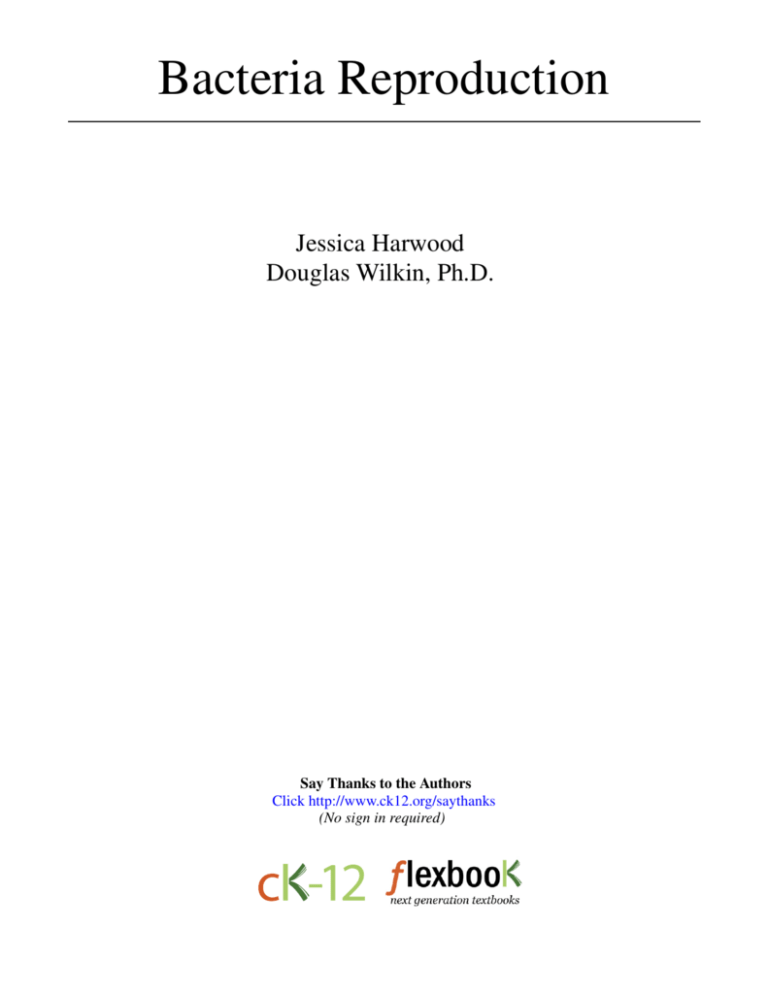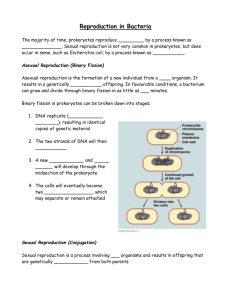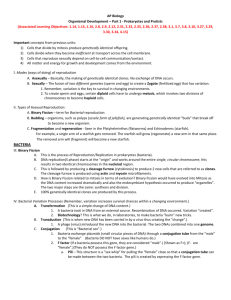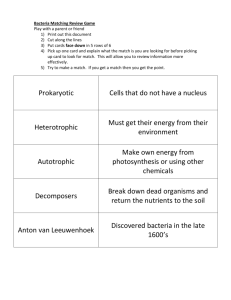Bacteria Reproduction
advertisement

Bacteria Reproduction Jessica Harwood Douglas Wilkin, Ph.D. Say Thanks to the Authors Click http://www.ck12.org/saythanks (No sign in required) To access a customizable version of this book, as well as other interactive content, visit www.ck12.org AUTHORS Jessica Harwood Douglas Wilkin, Ph.D. EDITOR Douglas Wilkin, Ph.D. CK-12 Foundation is a non-profit organization with a mission to reduce the cost of textbook materials for the K-12 market both in the U.S. and worldwide. Using an open-source, collaborative, and web-based compilation model, CK-12 pioneers and promotes the creation and distribution of high-quality, adaptive online textbooks that can be mixed, modified and printed (i.e., the FlexBook® textbooks). Copyright © 2015 CK-12 Foundation, www.ck12.org The names “CK-12” and “CK12” and associated logos and the terms “FlexBook®” and “FlexBook Platform®” (collectively “CK-12 Marks”) are trademarks and service marks of CK-12 Foundation and are protected by federal, state, and international laws. Any form of reproduction of this book in any format or medium, in whole or in sections must include the referral attribution link http://www.ck12.org/saythanks (placed in a visible location) in addition to the following terms. Except as otherwise noted, all CK-12 Content (including CK-12 Curriculum Material) is made available to Users in accordance with the Creative Commons Attribution-Non-Commercial 3.0 Unported (CC BY-NC 3.0) License (http://creativecommons.org/ licenses/by-nc/3.0/), as amended and updated by Creative Commons from time to time (the “CC License”), which is incorporated herein by this reference. Complete terms can be found at http://www.ck12.org/about/ terms-of-use. Printed: April 11, 2015 CONTRIBUTORS Doris Kraus, Ph.D. Niamh Gray-Wilson Jean Brainard, Ph.D. Sarah Johnson Jane Willan Corliss Karasov www.ck12.org C HAPTER Chapter 1. Bacteria Reproduction 1 Bacteria Reproduction • Define asexual reproduction. • Describe the process of binary fission. • Compare conjugation, transformation, and transduction. How can bacteria reproduce so rapidly? Bacteria can divide very rapidly. This image is of a growing colony of E. coli bacteria. In the right environment, a single E. coli can divide to form a colony of hundreds of bacteria in just a few hours. Bacteria Reproduction Bacteria, being single-celled prokaryotic organisms, do not have a male or female version. Bacteria reproduce asexually. In asexual reproduction, the "parent" produces a genetically identical copy of itself. Binary Fission Bacteria reproduce through a process called binary fission. During binary fission, the chromosome copies itself, forming two genetically identical copies. Then, the cell enlarges and divides into two new daughter cells. The two daughter cells are identical to the parent cell. Binary fission can happen very rapidly. Some species of bacteria can double their population in less than ten minutes! Exchanging DNA Sexual reproduction does not occur in bacteria. But not all new bacteria are clones. This is because bacteria can acquire new DNA. This process occurs in three different ways: 1 www.ck12.org 1. Conjugation: In conjugation, DNA passes through an extension on the surface of one bacterium and travels to another bacterium ( Figure 1.1). Bacteria essential exchange DNA via conjugation. 2. Transformation: In transformation, bacteria pick up pieces of DNA from their environment. 3. Transduction: In transduction, viruses that infect bacteria carry DNA from one bacterium to another. FIGURE 1.1 Bacteria can exchange small segments of DNA through conjugation. Notice two bacterial cells are attached by a short extension. DNA can be exchanged through this extension. Summary • Bacteria reproduce by binary fission, resulting in two daughter cells identical to the parent cell. • Bacteria can exchange DNA through the processes of conjugation, transformation, or transduction. Explore More Use the resources below to answer the questions that follow. Explore More I • Binary Fission at http://www.boundless.com/biology/cell-reproduction/prokaryotic-cell-division/binary-fiss ion/ 1. Define binary fission. 2. During replication, what is the relationship between the bacterial chromosome and the plasma membrane? 3. When do the daughter cells separate? Explore More II • Asexual Reproduction at http://www.youtube.com/watch?v=DY9DNWcqxI4 (1:03) 2 www.ck12.org Chapter 1. Bacteria Reproduction MEDIA Click image to the left or use the URL below. URL: http://www.ck12.org/flx/render/embeddedobject/57423 1. There are approximately 7 billion humans on the planet. How long would it take some bacteria to make 7 billion copies of themselves? Review 1. 2. 3. 4. Describe how bacteria reproduce? How do bacteria exchange DNA? What is binary fission? What is transformation involving bacteria? References 1. Watcharee Saisongkorh, Catherine Robert, Bernard La Scola, Didier Raoult, Jean-Marc Rolain/Public Library of Science. Conjugation in bacteria . CC BY 2.5 3









